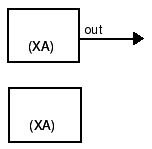1. Port-name does not exist on any instance of this type |
2. Non-Existent Port from Variable |
3. Inconsistent Connections |
4. Explicit Nulls |
5. Explicit NC's |
The table shows how -rigorous and -ncports can be used to find unintentially unconnected ports. When any ports are accidently left unconnected, -rigorous will not allow a successful build. The -ncports option is a compromise that will allow builds but will stop the simulation if a model ever attempts to use an unconnected port.
Table 1 - Effects of build-options on unconnected ports.
| Case | (default) | -lenient | -rigorous | -ncports | Run-Time | |
|
Build Error, fails w/message | Build Error, fails w/message | Build Error, fails w/message | Build Error, fails w/message | NA | |
|
Ok | Ok | Ok | Ok | On attempt to Send out non-existent port-name, simulation Stops w/Error Message. | |
|
Automatically adds null connections w/Warnings | Silently adds automatic null connections | Error message, fails build | Adds NC connections automatically | Ok, unless -ncports was used and Send is attempted on unconncted port, then sim stops w/Error message. | |
|
Ok | Ok | Ok | Ok | Ok (Inadvertent Sends on null ports absorbed without notice) | |
|
Ok | Ok | Ok | Ok | Ok, unless model attempts Send on NC port, simulation will Stop w/Error Message. |
(* Ok = Build or Sim proceeds normally without warning or error messages, or not applicable.)
Discussion:
Case 1: Port-name does not exist on any instance of this type - This is the case where a literal port-name is used (in quotes) in a SEND or RECEIVE of a behavioral model, but no instance of the given device-type ever has a port of that name connected to it. This error is detected at build-time regardless of the option settings.
Case 2: Non-Existent Port from Variable - This case is similar to Case-1 above, but instead of a literal port name that could be checked at build-time, a port-name variable is used in a SEND or RECEIVE of a behavioral model. At run-time, the port-name variable evaluates to an unknown port-name. This error is detected at run-time and stops the simulation with a fatal error message. (It cannot be detected at build-time under any options.)
Case 3: Inconsistent Connections - This is the case where models of the same type do not have all the same port connections. By default, this is treated as a potential missing connection. A default warning is issued and the missing port is terminated with a null connection. Since this situation is often intentional and ok with newer mdoels, these warnings can be suppressed by the -lenient checking option. Inadvertent sends or receives on the given port will be absorbed/ignored. In other situations where inconsistent ports should be considered errors, use the -rigorous option. Finally, in situations where unconnected ports are ok, but should not be used, then the -ncports option terminates unconnected ports with explicit NC terminators. Any attempted receives or sends on NC ports result in a fatal error message at simulation run-time.
Case 4: Explicit Nulls - Explicitly terminating ports with Null connections avoids build-time warning/error messages regardless of option settings, and causes any sends or receives on the given port at run-time to be absorbed/ignored. (These ports will be shielded from the -ncports option.)
Case 5: Explicit NC's - Explicitly terminating ports with NC connections avoids build-time warning/error messages regardless of option settings, but causes any sends or receives on the given port at run-time to raise a fatal error message and stop the simulation.
